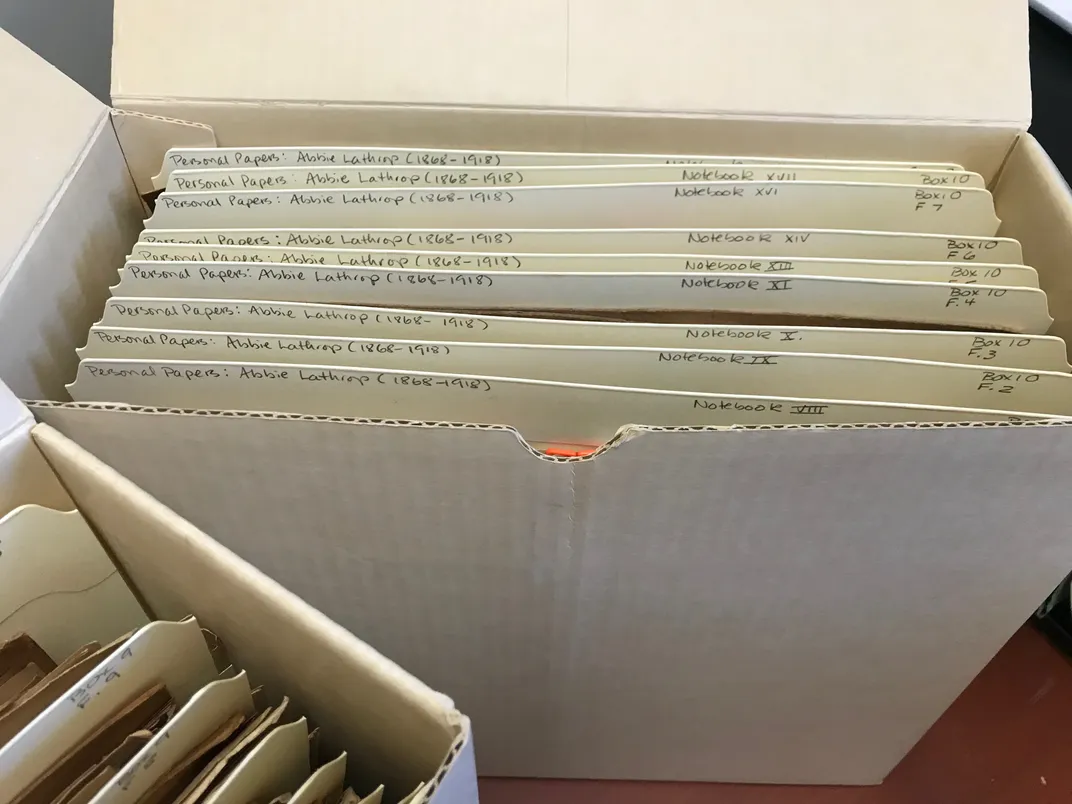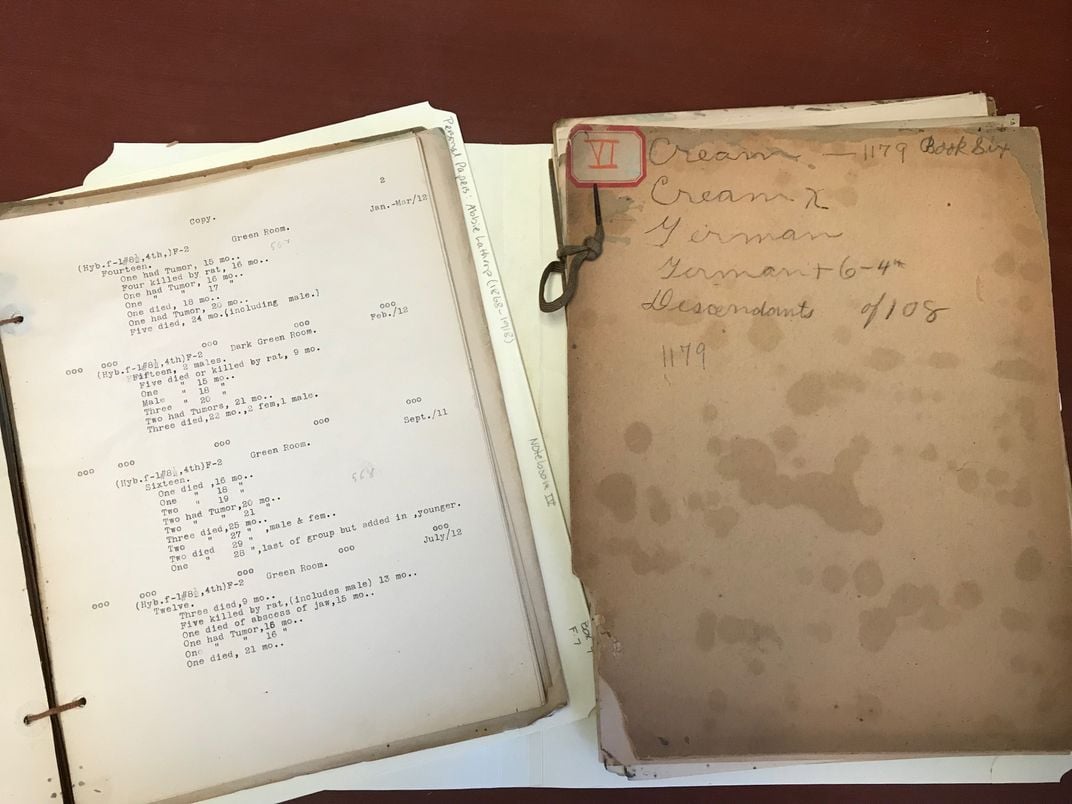The History of Breeding Mice for Science Begins With a Woman in a Barn
Far more than a mouse fancier, Abbie Lathrop helped establish the standard mouse model and pioneered research into cancer inheritance
/https://tf-cmsv2-smithsonianmag-media.s3.amazonaws.com/filer/f4/de/f4de41c6-e670-44d1-81af-e7c6658dbf8a/ba5dyh.jpg)
In her small white farmhouse in Granby, Massachusetts, Abbie E. C. Lathrop bred a variety of small animals: ferrets, rabbits, guinea pigs, rats, and, most notably, mice. In 1902, her mice became the first to be used in a lab for genetic research—and some still are today.
Not a trained scientist, Lathrop is often cast as a mere footnote in the history of cancer research, portrayed as an eccentric hobbyist who was oddly attracted to mice. But a closer look shows that she was a savvy business woman turned self-made scientist, whose careful and methodical mouse breeding helped advance modern cancer research and create a standard organism of science. Moreover, she published scientific papers on mice and cancer inheritance that set the stage for future cancer research.
The mice Lathrop started breeding more than a century ago have gone on to do amazing things. Since the 1960s, mice have been the first animals most pharmaceutical companies test new chemicals on in the hopes of moving on to humans. In the 1990s, the lab mouse helped launch the Human Genome Project; geneticists call the mouse genome the “Rosetta stone” because of its promise for helping us unlock our own. Worldwide, Dan Engber reports in Slate, scientists use nearly 90 million rats and mice for their experiments and testing every year.
Of course, mouse models come with their own problems—most lab mice today are badly overfed and genetically divorced from their natural cousins, and studies show they poorly mimic things like human inflammation—but it’s undeniable that they've revolutionized the science. So who is the woman behind the ubiquitous mouse model?
.....

An Unexpected Path
Lathrop was born in Illinois in 1868, the daughters of two school teachers from Granby. She was homeschooled until the age of 16, after which she had two years of formal schooling. At 19, she too went on to become a school teacher—but pernicious anemia, a disease of the red blood cells, forced her to retire after just a few years. In 1900, she moved to Granby to try her hand at poultry farming. The business soon failed.
Fortunately for history, she then turned to mice breeding. This was not as unusual in the early 20th century as it might seem today; breeding mice in captivity has been traced back to at least 17th century Japan, where fanciers and collectors bred mice for select genetic traits, like coat color or unique behaviors. In the United States and Britain, fancy (aka domesticated) mice experienced a surge in popularity in the early 20th century, with people keeping them for pets and breeding interesting specimens for mouse shows.
Lathrop began her new enterprise with two waltzing mice, a breed known for their bobbing and circling movement caused by mutation of the inner ear. Starting with a male and a female she had bred from wild mice, Lathrop multiplied her stock until it eventually reached to over 10,000 mice, housed in straw-filled wooden boxes and fed on oats and crackers. A skilled breeder, she was able to select traits to breed creamy buffs, white English sables, and other desirable coat variations for other mouse fanciers.
But her clientele quickly changed.
In 1902, geneticist William Ernest Castle of Harvard University's Bussey Institute of Boston placed his first order of mice from Lathrop. Castle, who was particularly interested in mammalian genetics, had found that mice with their short lifespans were an ideal specimen for research. Fortunately, Lathrop had already established the groundwork that would make her business an ideal supplier.
“Mouse breeders and fanciers essentially routinized the activity of mouse breeding in captivity well before scientists became interested in the mouse as an experimental organism,” writes historian of biology Karen Rader in her book Making Mice: Standardizing Animals for American Biomedical Research. In an interview with Smithsonian.com, Rader elaborated: “When genetics came along, geneticists realized quickly what they were looking with these fancy animals was repository of inbred animals where there was quite a bit of genetic control already built in.”
Lathrop soon found herself fulfilling orders for mice by the pound for laboratories.

Published Cancer Research
At the Bussey Institute, geneticist—and eugenicist—C.C. Little was put in charge of Castle's mouse colony. With mice from Lathrop’s Granby farm, the undergraduate Little began experimenting with inbred mouse strains and succeeded in breeding stable strains—what biologists and geneticists refer to as “pure.”
In 1909, he began inbreeding experiments with his successful stable strain, dba (dilute brown non-agoutis). He showed that inbreeding could cull and preserve genetic variants from the same genetic stock. For cancer research, this meant a stable breeding strain by which to study the biological and genetic nature of cancer in mice inbred with cancerous tumors—a realization that has defined mouse model research to this day.
During this same time period, Lathrop had begun her own investigation into cancer. After she noticed skin lesions on some of her mice, she sent inquiries out to her researcher customers to ask if theirs had developed lesions as well. Well-known pathologist Leo Loeb of the University of Pennsylvania replied, saying that he had determined the lesions to be cancerous. Though the letters of Lathrop and Loeb’s correspondence have been lost, we know that it resulted in a professional collaboration that produced pioneering work in cancer research.
Lathrop started carrying out experiments with cancer and inbred mice strains in 1910. According to Rader, their collaboration “represent[s] the first work establishing the connection between certain strains of mice and the inheritance of cancer.” They found that the incidence of cancerous tumors varied among strains (or families) of mice, concluding that if high-tumor strains bred with low-tumor strains, the offspring would resemble the high-tumor strain. Their collaboration further showed a connection between hormones and cancer: mammary tumors decreased in female mice with ovariectomies while the tumors increased in pregnant mice.
Between 1913 and 1919, Lathrop and Loeb co-authored 10 scientific papers based on their experiments, which appeared in presitigous journals including the Journal of Experimental Medicine and the Journal of Cancer Research. At this time, it was highly unusual for a woman to receive full co-authorship. However, it is Little who is credited with providing the foundational work on inbreeding, inheritance and cancer. In 1929, Little founded Jackson Laboratory (JAX), today a bustling cancer research hub and the world’s leading supplier for laboratory mice with over 7,000 unique genetic strains.
He started his endeavor with mice that originated from Lathrop’s stock. Today, JAX still supplies strains of mice that came from Lathrop’s Granby farm.

The Image of an Oddity
Rader contends that it is difficult to believe that Little did not know of Lathrop’s experiments with inbreeding and cancer taking place concurrently with his. Yet the only acknowledgement Little gave to Lathrop and her work was in a 1931 paper in which he refers to her as “a mouse fancier of more than ordinary care and scientific interest.” Little later claimed that he observed high tumor occurrence independently in his own dba strain.
Little’s errant reference to Lathrop reflects a larger systemic problem that denied women opportunity and recognition. “Lathrop was in part doing this cutting-edge stuff at home, because there weren’t spaces in universities yet that were well-established for doing that work,” Rader says. “And to the extent that there were, they were occupied by men.”
The press presented another challenge to Lathrop being viewed as the scientist she undoubtedly was. While she was running her mouse business, she was continually spotlighted in local and national media, including the Los Angeles Times, The New York Times, and The Washington Post. These articles presented her as an oddity, stressing how she conflicted with the gendered stereotype that women are afraid of mice.
A 1907 L.A. Times article on Lathrop opened with: “In the face of all tradition about women’s insane fear of a rat or a mouse, Miss Abbie E. C. Lathrop is earning a living by managing a rat and mice farm.” Others described her farm as “queer” (in the sense of odd), though in reality it wasn’t any more “queer” than what was being done in laboratories. Even today, Lathrop is often described as “eccentric”—yet her work exemplifies quite the opposite.
Lathrop’s scientific notebooks, now housed at JAX, reveal a woman who was both careful and methodical in her work. She kept detailed breeding records of all her different strains, wrote out histories of certain breeding families, and recorded her own observations of various strains and breeds. Her work in genetics and cancer research lives on both in her published research, and in the mice that continue to make their way to labs all over the world.
If she was an oddity, she was made one by social stereotypes and cultural constraints conferred upon her as a woman who practiced science in unexpected ways.

